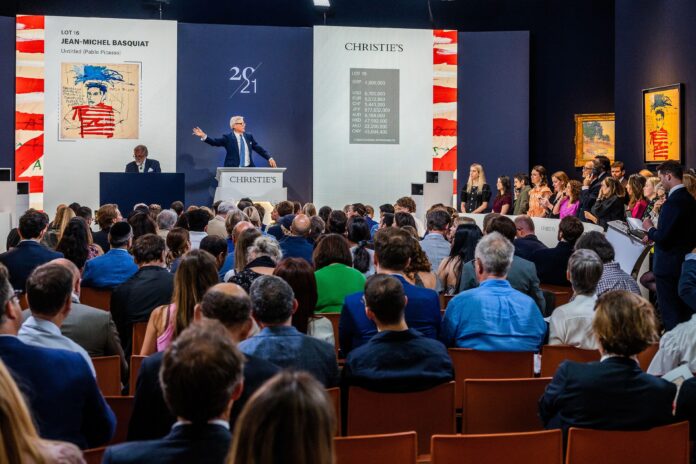Expectations were low and nerves running high ahead of Christie’s 20/21 evening sale in London today, which fetched £51.7m (£63.8m with fees) from 66 lots—down two thirds on the equivalent sale last year and short of its presale estimate of £55.2m-£80.8m.
Auction specialists acknowledged the prevailing climate of a cooling market, but stressed that “London is alive and kicking”, as Giovanna Bertazzoni put it. The vice-chairman of the 20th- and 21st-century department denied that Brexit was a factor in the dearth of consignments over the £5m-mark in the UK capital. “It’s not a lack of confidence in London because of Brexit, it’s more a market fatigue,” she adds.
The London-based art adviser Nilani Trent notes that sellers are aware that sales have “slowed down significantly” and private sales “are more appealing than taking a risk at auction”. Crucially, “it’s become harder to find masterpieces,” she says.
A masterpiece is in the eye of the beholder, and the two top lots of the sale were very distinct in every conceivable way. One, a portrait of Picasso by Jean-Michel Basquiat from 1984, went to the Nahmad family for £5.4m (£6.5m with fees) following a short bidding battle with Acquavella Galleries, which elicited a small ripple of applause in the saleroom as it concluded.
Christie’s head of evening sale Tessa Lord acknowledged that the painting was not the “definition of fresh to market”, having last sold at Christie’s in 2007 to an unnamed Italian collector. “But, in the Basquiat market, that is [fresh], given how quickly it’s moved,” she adds.

Paul Signac’s Calanque de Canoubier (Point de Bamer), (1896)
Courtesy of Christie’s
The other major lot of the afternoon was Paul Signac’s mellow landscape, Calanque de Canoubier (Point de Bamer), painted in 1896. The canvas, which hammered for £6.7m (£8m with fees; est £5.5m-£8m) to Olivier Camu, Christie’s deputy chairman for Impressionist and Modern art in London, had been the subject of a recent legal dispute—now settled—over its title. It came to the block with a last-minute third-party guarantee; it is one of seven lots to have found financial backers in the 48 hours leading up to the sale.
The painting’s appearance is perhaps more remarkable for an auction usually reserved for works created in the 20th and 21st centuries. A number of other earlier and Impressionist works that crept in included a dynamic drawing by Van Gogh of washerwomen dated 1885, which sold for £1.2m (£1.5m with fees; est £1.2m-£1.8m), and a self-portrait by Degas created in 1855 when the artist was just 21. It hammered above its high estimate of £350,000 for £440,000 (£554,400 with fees). According to Hugo Nathan, of Beaumont Nathan art, collectors are turning to established names as “the heat has come out of that very speculative contemporary market”.
A saccharine portrait of a seated woman by Renoir from 1886, meanwhile, was one of two lots to be withdrawn prior to the sale.
Overall, the auction achieved a very respectable 92% sell through rate, though several key works sold with hefty discounts. A gold porcelain sculpture by Louise Bourgeois hammered for £450,000 against a low estimate of £800,000; Howard Hodgkin’s The Spectator (1984-87) went for £590,000 (est £800,000-£1.2m); and an oil and graphite work on canvas by Cy Twombly sold for £1.2m against a £2m low estimate.
Contrary to popular thought, the market doesn’t always respond to fresh material. Among the works to go unsold—and one of the biggest disappointments of the day—was an early photorealist landscape by Gerhard Richter, estimated to fetch £4m-£6m. Acquired directly from the artist by the consignor in 1975, the work has just come off the walls of the Kunstmuseum Bonn where it has been on longterm loan since 2001. Lord maintains that Richter “continues to be one of the most in demand artist today”, but suggests this painting represents a part of the German artist’s oeuvre “that has room for development and growth”. Works by Otto Mueler, Pierre Bonnard, Carl Andre and Sam Gilliam also failed to find homes.
Fair-tigue meets auction exhaustion
Usually active, American and Asian bidders were noticeably absent in tonight’s sale, which was “quite European in identity”, Lord says, noting that fewer specialists had flown in from Asia. Buyers were “overwhelmingly European”, Bertazzoni adds. Bidding came from Brussels, Spain, Italy, France and Germany, a Christie’s spokeswoman confirmed. For the past two years, Christie’s has held London-to-Paris auctions consecutively but, now travel restrictions have completely lifted, that format is apparently a thing of the past.
Nathan suggests American buyers in particular are “spent out” after the “weight of the New York auctions” last month. He adds: “Christie’s put all their eggs in the New York basket, they had vast sales in New York. There’s an argument that they could have held something back for London, but I think everyone wanted to hurry.”
He notes how the global rise in interest rates have caused a contraction in the market, particularly in the first six months of this year. “The conservative defensive strategy is to put everything into the big marquee auctions in New York, and also to go with guarantees,” Nathan adds. “The thing is, when guarantees land with the guarantors, there are a lot less guarantors available the next season, and without the third party guarantors, the auction houses struggle to get the material.”
Nonetheless, rival Sotheby’s managed to secure the material for yesterday’s evening sale, notably in the shape of an unusual but impeccably marketed Gustav Klimt painting, which sold for £85.3m (with fees)—a record auction price in Europe. Crucially, it was guaranteed at a level likely to be around its £65m estimate.
In a rare moment of collegiality between the houses, Bertazzoni says that result is “a big vote of confidence” in London, adding: “There’s the sense that London isn’t what it was, but everybody wants it to be. There’s absolutely this willingness to keep it going.”

























